基于Patrice Swarm Optimization的云计算多目标任务调度(IJITCS-V7-N5-9)
基于粒子群的工业大数据雾计算多目标优化任务调度算法
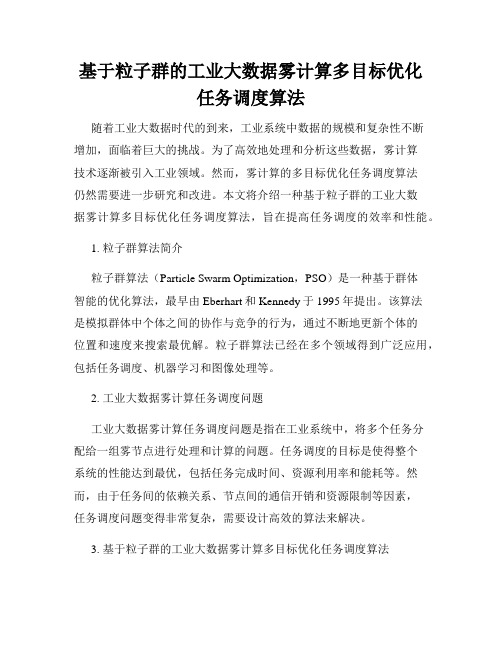
基于粒子群的工业大数据雾计算多目标优化任务调度算法随着工业大数据时代的到来,工业系统中数据的规模和复杂性不断增加,面临着巨大的挑战。
为了高效地处理和分析这些数据,雾计算技术逐渐被引入工业领域。
然而,雾计算的多目标优化任务调度算法仍然需要进一步研究和改进。
本文将介绍一种基于粒子群的工业大数据雾计算多目标优化任务调度算法,旨在提高任务调度的效率和性能。
1. 粒子群算法简介粒子群算法(Particle Swarm Optimization,PSO)是一种基于群体智能的优化算法,最早由Eberhart和Kennedy于1995年提出。
该算法是模拟群体中个体之间的协作与竞争的行为,通过不断地更新个体的位置和速度来搜索最优解。
粒子群算法已经在多个领域得到广泛应用,包括任务调度、机器学习和图像处理等。
2. 工业大数据雾计算任务调度问题工业大数据雾计算任务调度问题是指在工业系统中,将多个任务分配给一组雾节点进行处理和计算的问题。
任务调度的目标是使得整个系统的性能达到最优,包括任务完成时间、资源利用率和能耗等。
然而,由于任务间的依赖关系、节点间的通信开销和资源限制等因素,任务调度问题变得非常复杂,需要设计高效的算法来解决。
3. 基于粒子群的工业大数据雾计算多目标优化任务调度算法为了解决工业大数据雾计算任务调度问题,本文提出了一种基于粒子群的多目标优化任务调度算法。
该算法以任务调度的多个优化目标为约束条件,通过控制粒子的位置和速度来搜索最优解集合。
具体的算法步骤如下:步骤一:初始化粒子群和搜索空间。
设置粒子群中每个粒子的位置和速度,并确定搜索空间的范围。
步骤二:计算粒子的适应度值。
根据当前粒子的位置和速度,计算其适应度值,即任务调度的多个优化目标。
步骤三:更新粒子的位置和速度。
根据粒子群中历史最优解和全局最优解,更新粒子的位置和速度,以搜索更好的解。
步骤四:判断终止条件。
如果达到了预设的终止条件(如迭代次数或目标函数值的收敛性),则停止算法;否则,转到步骤二继续迭代。
云计算中基于改进离散粒子群优化的任务调度方案

第33卷第4期2017年7月齐齐哈尔大学学报(自然科学版)Journal of Qiqihar University(Natural Science Edition)Vol.33,No.4July,2017云计算中基于改进离散粒子群优化的任务调度方案郑建秋(厦门城市职业学院,福建厦门361009)摘要:针对云计算中现有智能任务调度算法容易陷入局部最优的问题,提出一种基于改进型离散粒子群优化(D P S0)算法的任务调度方案。
对传统DPS0算法中的粒子位置更新公式中的惯性权重进行改进,使其根据迭代次数非线性递减,提高算法的搜索能力;另外,融入了随机扰动操作,避免算法陷入局部最优。
实验结果表明,与传统遗传算法和粒子群算法相比,该方案能够获得最优的调度策略,有效降低任务的完成时间。
关键词:云计算;任务调度;离散粒子群优化;惯性权重;随机扰动中图分类号:TP306.1 文献标志码:兴文章编号:1007-984X(2017)04-0006-05云计算代1]是一种新的计算技术,用户可以利用云计算租借软件、硬件、基础设施和计算资源作为每个 用户的基础资源,并将他们的工作提交给云计算处理或者云存储。
云计算中的用户任务通常以工作流方式 进行。
科学工作流代2以是指将一系列在科学研究中遇到的数据管理、计算、分析等工作变成一个个独立的服 务,再把这些服务通过数据链接组合在一起,满足研究人员科学实验和数据处理中的需要,从而实现相应 的处理与科学计算'传统的计算环境已很难满足科学工作流的需要。
云计算以高性能的计算资源与海量 的存储资源为科学工作流应用提供了一种全新的部署和执行方式'目前,云计算环境下工作流任务调度方案作为云计算工作流技术的重要组成部分,已经成为该领域内 的研究热点。
工作流任务调度的主要目标是减少任务执行的总时间,减少资源的空闲时间,提高了资源利 用率代4]。
任务调度是一个组合NP-完全问题,启发式智能算法是解决这种问题的一种有效手段,常用的智 能算法有遗传算法(GA)、粒子群算法(PS0)、蚁群算法(AC0)等。
基于粒子群优化与蚁群优化的云计算任务调度算法
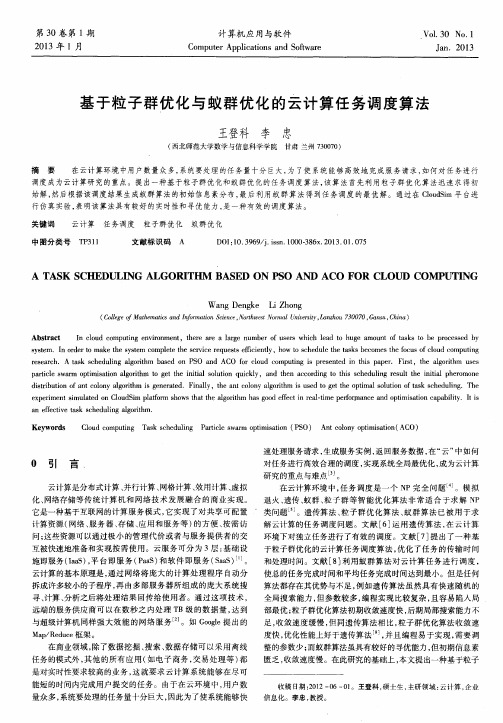
7 r r I NG
Wa ng De n g k e L i Zh o n g
( C o l l e g e o fMa t h e m a t i c s a n d I n f o r ma t i o n&据 , , N o r t h w e s t N o r m a l U n i v e r s i t y , L a n z h o u 7 3 0 0 7 0 , G a n s u , C h i n a )
始解, 然后根据该调度结果生成蚁群算法的初始信息素分布, 最后利用蚁群算法得到任务调度的最优解。通过在 C l o u d S i m平 台进
行仿真实验 , 表 明该算法具有较好 的实 时性和寻优能力 , 是 一种有效 的调度算法 。
关键词
中 图分 类 号
云计算
任 务调度
粒子群优 化 蚁 群 优 化
A
D O I : 1 0 . 3 9 6 9 / j . i s s n . 1 0 0 0 — 3 8 6 x . 2 0 1 3 . 0 1 . 0 7 5
T P 3 1 1
文献标识码
A TAS K S CHEDUL I NG AL GORI T HM BAS E D oN P S O AND ACO F数学与信 息科学学 院 甘肃 兰州 7 3 0 0 7 0 )
满足帕累托最优的多目标云工作流调度算法
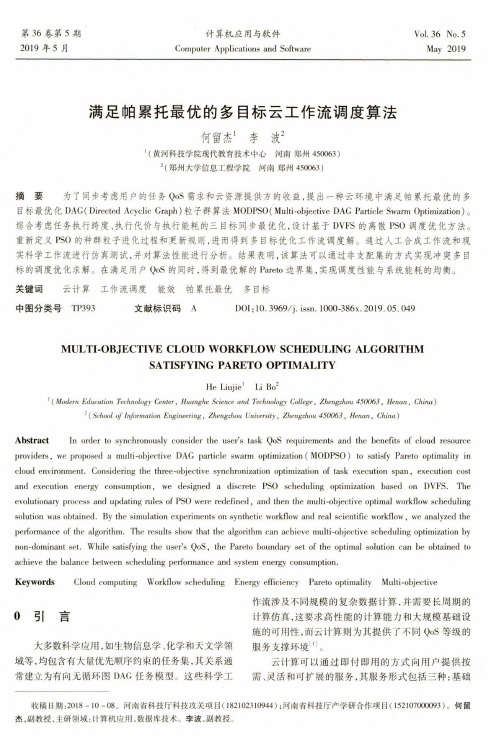
290
计算机应用与软件
2019 年
设施即服务IaaS、平台即服务PaaS和软件即服务 SaaS。而云环境中的工作流DAG任务调度问题需要 考虑的因素更多更复杂[2]:1)用户多样的QoS需求, 如:服务响应时间、服务代价等;2)云服务具有异质、 动态和弹性特征;3)联合云服务执行工作流任务的方 式多样;4)数据传输量更大。然而,工作流调度问题 本质上是联合优化问题,无法通过简单启发式算法或 规则找到全局最优解,是NP-完全问题,且与求解问题 规模紧密相关。
Keywords Cloud computing Workflow scheduling Energy efficiency Pareto optimality Multi-objective
o引言
大多数科学应用,如生物信息学、化学和天文学领 域等,均包含有大量优先顺序约束的任务集,其关系通 常建立为有向无循环图DAG任务模型。这些科学工
He Liujie1 Li Bo2
1 (Modern Education Technology Center, Huanghe Science and Technology College, Zhengzhou 450063, Henan, China) 2 (School of Information Engineering, Zhengzhou University, Zhengzhou 450063, Henan, China)
摘 要 为了同步考虑用户的任务QoS需求和云资源提供方的收益,提出一种云环境中满足帕累托最优的多 目标最优化 DAG( Directed Acyclic Graph)粒子群算法 MODPSO( Multi-objective DAG Particle Swarm Optimization) o 综合考虑任务执行跨度、执行代价与执行能耗的三目标同步最优化,设计基于DVFS的离散PSO调度优化方法。 重新定义PSO的种群粒子进化过程和更新规则,进而得到多目标优化工作流调度解。通过人工合成工作流和现 实科学工作流进行仿真测试,并对算法性能进行分析。结果表明,该算法可以通过非支配集的方式实现冲突多目 标的调度优化求解。在满足用户QoS的同时,得到最优解的Pareto边界集,实现调度性能与系统能耗的均衡。
面向云计算的多目标优化调度算法研究
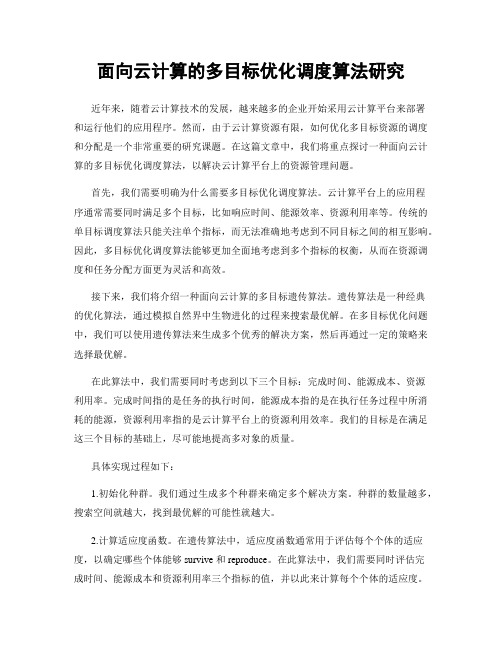
面向云计算的多目标优化调度算法研究近年来,随着云计算技术的发展,越来越多的企业开始采用云计算平台来部署和运行他们的应用程序。
然而,由于云计算资源有限,如何优化多目标资源的调度和分配是一个非常重要的研究课题。
在这篇文章中,我们将重点探讨一种面向云计算的多目标优化调度算法,以解决云计算平台上的资源管理问题。
首先,我们需要明确为什么需要多目标优化调度算法。
云计算平台上的应用程序通常需要同时满足多个目标,比如响应时间、能源效率、资源利用率等。
传统的单目标调度算法只能关注单个指标,而无法准确地考虑到不同目标之间的相互影响。
因此,多目标优化调度算法能够更加全面地考虑到多个指标的权衡,从而在资源调度和任务分配方面更为灵活和高效。
接下来,我们将介绍一种面向云计算的多目标遗传算法。
遗传算法是一种经典的优化算法,通过模拟自然界中生物进化的过程来搜索最优解。
在多目标优化问题中,我们可以使用遗传算法来生成多个优秀的解决方案,然后再通过一定的策略来选择最优解。
在此算法中,我们需要同时考虑到以下三个目标:完成时间、能源成本、资源利用率。
完成时间指的是任务的执行时间,能源成本指的是在执行任务过程中所消耗的能源,资源利用率指的是云计算平台上的资源利用效率。
我们的目标是在满足这三个目标的基础上,尽可能地提高多对象的质量。
具体实现过程如下:1.初始化种群。
我们通过生成多个种群来确定多个解决方案。
种群的数量越多,搜索空间就越大,找到最优解的可能性就越大。
2.计算适应度函数。
在遗传算法中,适应度函数通常用于评估每个个体的适应度,以确定哪些个体能够 survive 和 reproduce。
在此算法中,我们需要同时评估完成时间、能源成本和资源利用率三个指标的值,并以此来计算每个个体的适应度。
3.选择优秀个体并进行交叉和变异。
在遗传算法中,我们需要通过交叉和变异的方式随机生成新的解决方案。
与传统的遗传算法不同的是,我们需要同时考虑到多个指标的影响,以生成更优秀的解决方案。
基于烟花算法的云计算多目标任务调度
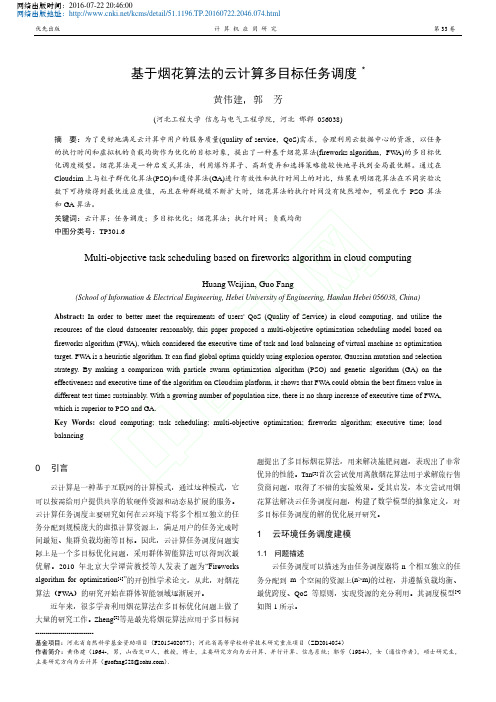
优先出版
计 算 机 应 用 研 究
第 33 卷
serCapacity
j
proNum
j
MIPS
j
BW
j
(5)
MIPSj 为每个处理器 其中 proNumj 为虚拟机 VMj 的处理器数量; 每秒产生的指令数量;BWj 为虚拟机 VMj 的网络带宽能力。则 系统最大服务能力为:
serCapacity max m serCapacity j j 1
[6]
x
t (i=1,2,…,scale),t=1 i
2. While(当前迭代次数<设定迭代次数)do 3. for 所有烟花 t do
x i
。爆炸强度使得适应度值较好的烟花产生的火花个数较多;
4.
由公式(12)计算 t 的适应度值;
x i
爆炸幅度使得它们有效地收敛到各个极值;位移操作可以保证 种群的多样性。 c)通过高斯变异在选中的烟花和最好的烟花之间进行变 异,产生新的火花,即新的调度解。 d)对高斯变异后超出边界的火花应用映射规则。 e)应用选择策略得到下一代的烟花群体。 f)判断是否满足终止条件。终止条件可以是满足问题的精 度要求或者是达到最大函数评估次数。 2.2 多目标优化 适应度值用来评价群体智能算法中个体的优劣程度,适应 度值越大,则个体越好,反之个体越差。多目标调度烟花算法 的主要思想是通过计算各个烟花的适应度值来确定每个烟花产 生的火花数量,让适应度值好的烟花产生更多的火花,适应度 值差的烟花产生更少的火花。 根据适应度函数的设计原则, 设
0
引言
云计算是一种基于互联网的计算模式,通过这种模式,它
可以按需给用户提供共享的软硬件资源和动态易扩展的服务。 云计算任务调度主要研究如何在云环境下将多个相互独立的任 务分配到规模庞大的虚拟计算资源上,满足用户的任务完成时 间最短、集群负载均衡等目标。因此,云计算任务调度问题实 际上是一个多目标优化问题,采用群体智能算法可以得到次最 优解。 2010 年北京大学谭营教授等人发表了题为 “Fireworks algorithm for optimization[1]”的开创性学术论文,从此,对烟花 算法(FWA)的研究开始在群体智能领域逐渐展开。 近年来,很多学者利用烟花算法在多目标优化问题上做了 大量的研究工作。
基于粒子群算法求解多目标优化问题

基于粒子群算法求解多目标优化问题一、本文概述随着科技的快速发展和问题的日益复杂化,多目标优化问题在多个领域,如工程设计、经济管理、环境保护等,都显得愈发重要。
传统的优化方法在处理这类问题时,往往难以兼顾多个目标之间的冲突和矛盾,难以求得全局最优解。
因此,寻找一种能够高效处理多目标优化问题的方法,已成为当前研究的热点和难点。
粒子群算法(Particle Swarm Optimization, PSO)作为一种群体智能优化算法,具有收敛速度快、全局搜索能力强等优点,已经在多个领域得到了广泛应用。
近年来,粒子群算法在多目标优化问题上的应用也取得了显著的成果。
本文旨在探讨基于粒子群算法求解多目标优化问题的原理、方法及其应用,为相关领域的研究提供参考和借鉴。
本文首先介绍多目标优化问题的基本概念和特性,分析传统优化方法在处理这类问题时的局限性。
然后,详细阐述粒子群算法的基本原理和流程,以及如何将粒子群算法应用于多目标优化问题。
接着,通过实例分析和实验验证,展示基于粒子群算法的多目标优化方法在实际问题中的应用效果,并分析其优缺点。
对基于粒子群算法的多目标优化方法的发展趋势和前景进行展望,为未来的研究提供方向和建议。
二、多目标优化问题概述多目标优化问题(Multi-Objective Optimization Problem, MOP)是一类广泛存在于工程实践、科学研究以及社会经济等各个领域中的复杂问题。
与单目标优化问题只寻求一个最优解不同,多目标优化问题涉及多个相互冲突的目标,这些目标通常难以同时达到最优。
因此,多目标优化问题的解不再是单一的最优解,而是一组在各个目标之间达到某种平衡的最优解的集合,称为Pareto最优解集。
多目标优化问题的数学模型通常可以描述为:在给定的决策空间内,寻找一组决策变量,使得多个目标函数同时达到最优。
这些目标函数可能是相互矛盾的,例如,在产品设计中,可能同时追求成本最低、性能最优和可靠性最高等多个目标,而这些目标往往难以同时达到最优。
基于改进粒子群算法的云计算任务调度算法
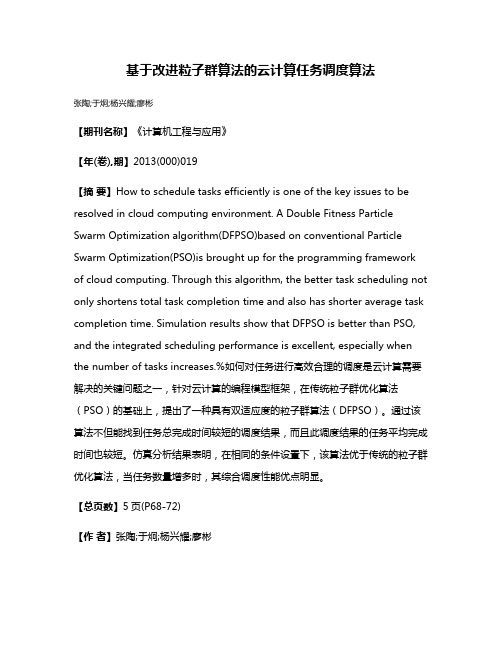
基于改进粒子群算法的云计算任务调度算法张陶;于炯;杨兴耀;廖彬【期刊名称】《计算机工程与应用》【年(卷),期】2013(000)019【摘要】How to schedule tasks efficiently is one of the key issues to be resolved in cloud computing environment. A Double Fitness Particle Swarm Optimization algorithm(DFPSO)based on conventional Particle Swarm Optimization(PSO)is brought up for the programming framework of cloud computing. Through this algorithm, the better task scheduling not only shortens total task completion time and also has shorter average task completion time. Simulation results show that DFPSO is better than PSO, and the integrated scheduling performance is excellent, especially when the number of tasks increases.%如何对任务进行高效合理的调度是云计算需要解决的关键问题之一,针对云计算的编程模型框架,在传统粒子群优化算法(PSO)的基础上,提出了一种具有双适应度的粒子群算法(DFPSO)。
通过该算法不但能找到任务总完成时间较短的调度结果,而且此调度结果的任务平均完成时间也较短。
仿真分析结果表明,在相同的条件设置下,该算法优于传统的粒子群优化算法,当任务数量增多时,其综合调度性能优点明显。
基于粒子群优化算法的多目标优化问题求解

基于粒子群优化算法的多目标优化问题求解摘要多目标优化问题是现代科学技术中经常遇到的问题之一。
传统的优化算法难以有效地解决这类问题,因此需要一种高效的优化算法来解决这种问题。
粒子群优化算法(Particle Swarm Optimization, PSO)作为一种新兴的优化算法,在多目标优化问题中表现出了良好的效果,本文将介绍基于粒子群优化算法的多目标优化问题求解的思路和方法。
1. 引言随着现代科学技术的不断发展,各行各业都涉及到了多目标优化问题。
例如,自动化工厂调度、工厂布局优化、电力系统调度等领域都需要解决多目标优化问题,传统的优化算法在解决这类问题上显得无能为力。
因此,研究高效的解决多目标优化问题的算法已成为当前的研究热点。
2. 多目标优化问题的定义与分类多目标优化问题(Multi-objective Optimization Problem, MOP)是指存在多个相互矛盾的目标函数需要最小化或最大化的优化问题。
多目标优化问题具有多样性、复杂性和不确定性等特点,它的解决涉及到数学、统计、计算机等多个领域。
根据问题的特征,多目标优化问题可分为以下几类:(1)在选择解时采用 Pareto 最优的非支配解集(Pareto Optimal Non-Dominated Solution Set, PONDS)作为解的选择标准,通常称为 Pareto 优化问题。
Pareto优化问题的主要研究方向是改进搜索算法和维护非支配解集。
(2)基于权衡的多目标优化问题。
在权衡的多目标优化问题中,目标函数的权值在不同的情况下有所不同,因此需要对不同权值下的优化结果进行比较,然后选择最优的结果。
该问题通常用加权平均法或效用函数法等方法来求解。
(3)约束多目标优化问题。
约束多目标优化问题是指在多目标优化问题的基础上,加入了约束条件。
该问题中要求解最优解,同时需要满足一定的约束条件。
3. 粒子群优化算法的概述粒子群优化算法(PSO)是一种优化算法,它是由Kennedy和Eberhart在1995年提出的。
基于改进蚁群算法的微电网多目标优化调度
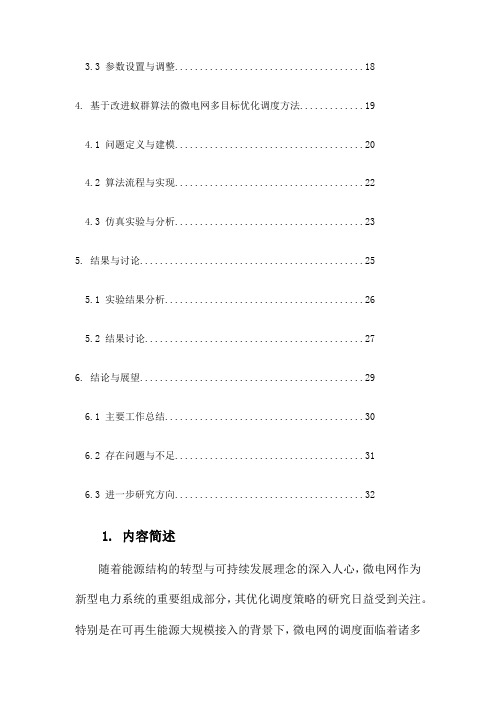
基于改进蚁群算法的微电网多目标优化调度目录1. 内容简述 (2)1.1 研究背景 (3)1.2 研究目的 (4)1.3 研究意义 (5)1.4 国内外研究现状 (6)1.5 本文的主要贡献 (8)2. 相关理论基础 (9)2.1 蚁群算法 (10)2.2 微电网优化调度 (11)2.3 多目标优化方法 (13)3. 改进蚁群算法模型的构建 (14)3.1 蚂蚁个体的适应度函数 (16)3.2 信息素更新规则的改进 (16)3.3 参数设置与调整 (18)4. 基于改进蚁群算法的微电网多目标优化调度方法 (19)4.1 问题定义与建模 (20)4.2 算法流程与实现 (22)4.3 仿真实验与分析 (23)5. 结果与讨论 (25)5.1 实验结果分析 (26)5.2 结果讨论 (27)6. 结论与展望 (29)6.1 主要工作总结 (30)6.2 存在问题与不足 (31)6.3 进一步研究方向 (32)1. 内容简述随着能源结构的转型与可持续发展理念的深入人心,微电网作为新型电力系统的重要组成部分,其优化调度策略的研究日益受到关注。
特别是在可再生能源大规模接入的背景下,微电网的调度面临着诸多挑战,如能源分配的动态性、能源需求的多样性以及系统稳定性的维护等。
引入智能算法对微电网进行优化调度显得尤为重要。
基于改进蚁群算法(Ant Colony Optimization, ACO)的微电网多目标优化调度是一种结合了人工智能与微电网调度技术的创新方法。
该策略旨在通过模拟自然界中蚁群的寻优行为,构建智能优化算法,实现对微电网系统的多目标协同优化。
其主要内容包括以下几个方面:问题定义与建模:将微电网的优化调度问题转化为多目标决策问题,构建相应的数学模型和决策框架。
这些模型会涵盖电力供需平衡、经济性指标、可再生能源的最大化利用以及系统稳定性等多个目标。
蚁群算法的应用与改进:引入蚁群算法进行寻优计算,并根据微电网的实际需求对其进行适应性改进。
云计算中的多任务调度算法研究与优化

云计算中的多任务调度算法研究与优化随着云计算的迅速发展,越来越多的人开始认识到多任务调度算法对于云计算平台的重要性。
多任务调度算法是云计算系统中的关键技术之一,它能够在满足各种约束条件的情况下,有效地将多个任务分配给云计算资源,提高资源利用率和运行效率。
本文将对云计算中的多任务调度算法进行研究与优化。
首先,我们来介绍云计算中的多任务调度算法。
多任务调度算法是指将不同的任务分配给云计算平台上的多个资源节点,以实现任务的高效执行。
常见的多任务调度算法包括作业优先级调度算法、最短作业优先调度算法、时间片轮转调度算法等。
这些算法通过考虑任务的优先级、执行时间和资源需求等因素,确定任务的执行顺序和分配方式,以提高系统的效率和性能。
然而,传统的多任务调度算法在应对复杂的云计算环境时存在一些不足之处。
首先,资源利用率不高。
传统算法往往只考虑任务的执行时间和优先级等因素,而忽视了资源的动态变化。
云计算平台中的资源分配是动态的,随着时间的推移和任务的变化,资源的利用率往往不高。
其次,执行时间长的作业可能会影响整个系统的运行效率。
如果没有合理地分配资源,执行时间长的作业可能会阻塞其他任务的执行,导致整个系统的运行效率下降。
为了解决这些问题,研究人员提出了一些优化的多任务调度算法。
这些算法使用了更加复杂的调度策略,考虑了更多的因素,以提高系统的性能和效率。
例如,最佳适应算法可以根据任务的资源需求和执行时间,动态地分配资源,以最大化系统的利用率。
进化算法通过模拟生物进化过程,自适应地调整任务的执行顺序和分配方式,优化整个系统的性能。
此外,还有一些基于机器学习和人工智能的算法,可以根据历史数据和预测模型,预测任务的资源需求和执行时间,从而实现更加精确的任务调度。
除了算法本身的优化,还可以通过优化云计算平台的资源管理策略,来提高多任务调度算法的效果。
例如,可以使用虚拟机迁移技术,将正在执行的任务迁移到其他资源节点,以实现负载均衡和优化资源利用率。
基于粒子群算法的多目标优化问题研究

基于粒子群算法的多目标优化问题研究1.引言多目标优化问题是现代工程设计和决策中经常遇到的问题之一,因为现实中往往需要优化多个目标。
传统的单目标优化问题只考虑一个目标函数,因此无法很好地解决多目标优化问题。
粒子群算法(Particle Swarm Optimization,PSO)是一种启发式优化算法,它已经广泛应用于多个领域中的优化问题。
本文将介绍粒子群算法以及基于粒子群算法的多目标优化问题研究。
2.粒子群算法原理粒子群算法是一种通过模拟自然界中鸟群或鱼群等生物群体行为来进行优化的算法,该算法由Eberhart和Kennedy在1995年提出。
粒子群算法将优化问题看作是在一个多维空间中的搜索问题,将解空间中的每一个可能的解看作一个粒子,各个粒子按照一定规则进行搜索,不断更新粒子位置和速度来寻找全局最优解。
在粒子群算法中,每个粒子都有位置和速度两个向量,位置向量表示当前的解,速度向量表示粒子的移动方向和速度大小。
在搜索过程中,每个粒子会记录自己目前找到的最优解,而全局最优解则是所有粒子的最优解中的最优解。
搜索过程中,粒子按照自身的最优解和全局最优解来调整速度和位置,以期望找到某个局部最优解,最终在搜索过程结束时得到全局最优解。
3.基于粒子群算法的多目标优化问题研究多目标优化问题需要同时优化多个目标函数,这些目标函数往往是相互矛盾的,因此需要找到一组解,这些解可以尽可能地满足多个目标函数的要求。
本章将介绍基于粒子群算法的多目标优化问题研究的方法。
3.1 基本方法在基于粒子群算法的多目标优化问题研究中,最常用的方法是多目标粒子群算法(Multi-objective Particle Swarm Optimization,MOPSO)。
该算法通过对粒子速度和位置的调整,以期望找到多个目标函数的 Pareto 前沿(Pareto Front),并从中选择最优解。
MOPSO 算法中,每个粒子的位置和速度向量都需要根据多个目标函数来计算。
云计算中基于改进遗传算法的多目标优化调度

用户提交任务至任务请求管理器,经过任务预处理至调度管理器,基于改进遗传算法的智能调度方法 部署在调度管理器中,其系统结构见图1。图1 中,用户通过用户接口提交任务请求至请求管理器,请求管
; 收稿日期: 修回日期: ?
2019 - 09 - 26
2019 - 11 - 04
基金项目:广东省自然科学基金(2018A030307078、2019A1515011402);广东石油化工学院博士启动项目(2017bs02)
优化。结果表明,相对于其它类似调度方法,所提出的调度方法在完成时间、费用和截止时间超出率方面均有明显优势。
关键词:云计算;多目标优化;任务调度;遗传算法
中图分类号:TP393
文献标识码:A
文章编号: ( ) 2095 - 2562 2020 01 - 0035 - 05
随着云计算的普及,云数据中心的规模和数量迅猛增长,调度问题成为云计算发展的关键,调度策略 是云计算实现高效计算的重要因素。对此很多学者提出了一些解决方案,如对负载进行管理[1]、对应用 数据进行划分优化[2]等,但无论是针对资源负载还是数据应用,都要面对如何尽可能满足用户多方面需 求的情况下提高调度效率。而对于这种多目标优化问题的求解很多学者提出了采用一些智能仿生算法来 实现[3,4],如非支配排序算法(NSGA - ) 、 II [5] Pareto 支配进化算法(SPEA2)[6]、基于参考信息的进化算法 (PAES)[7]等。文献[8]提出了一种偏好向量引导的高维目标协同进化算法。文献[9]提出了一种利润敏 感的空间调度方法,其主要目标是服务商利润最大化,它采用基于遗传、模拟退火的粒子群优化算法实现。 文献[10]针对IaaS 的工作流调度问题,提出了一种进化算法来实现最大化完工时间和成本的优化。文献 [11]针对云计算中任务的截止时间约束问题,提出一种基于二部图模型的调度算法。文献[12]针对端到 端延迟约束问题提出一种启发式调度算法。文献[13]提出一种基于改进粒子群的优化算法。文献[14] 为了降低任务执行成本提出一种改进遗传算法,它的主要目标在于降低工作流调度的成本。文献[15]提 出了一种多目标调度方法,它的主要优化目标为整个系统的吞吐量。文献[16]提出了一种融合布谷鸟搜 索算法与基于对立的学习算法结合的方法,以提高云计算中的性能并降低成本。这些研究多是从云计算 提供方的角度出发,对云计算系统调度问题提出的调度方法,多目标优化也是针对云计算提供商的角度提 出对性能和成本费用的优化。基于此,本文将从用户角度出发,针对用户对截止时间和费用的需求差异, 研究云计算中的任务完成时间和费用的均衡调度问题,从而提高调度完成效率并减少用户的花费。本文 提出了一种基于改进遗传算法的调度方法,同时考虑截止时间和费用预算两个约束条件下,尽可能实现时 间和费用均衡最优化。
基于pareto最优解集的多目标人工萤火虫群优化算法(ICMAL2011)
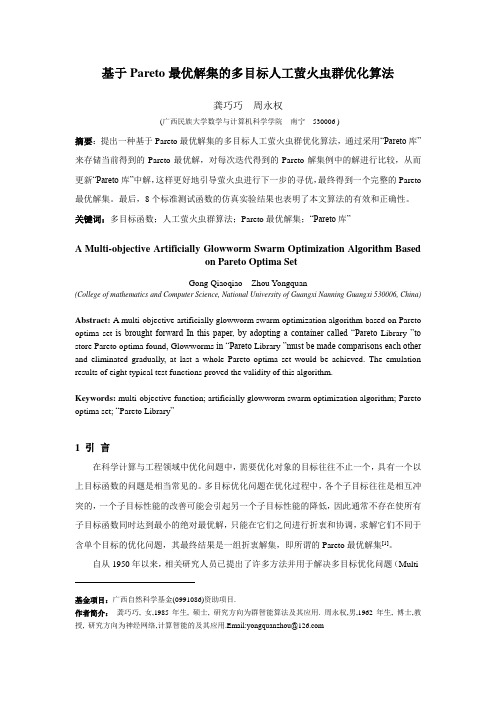
基于Pareto最优解集的多目标人工萤火虫群优化算法龚巧巧周永权(广西民族大学数学与计算机科学学院南宁530006 )摘要:提出一种基于Pareto最优解集的多目标人工萤火虫群优化算法,通过采用“Pareto库”来存储当前得到的Pareto最优解,对每次迭代得到的Pareto解集例中的解进行比较,从而更新“Pareto库”中解,这样更好地引导萤火虫进行下一步的寻优,最终得到一个完整的Pareto 最优解集。
最后,8个标准测试函数的仿真实验结果也表明了本文算法的有效和正确性。
关键词:多目标函数;人工萤火虫群算法;Pareto最优解集;“Pareto库”A Multi-objective Artificially Glowworm Swarm Optimization Algorithm Basedon Pareto Optima SetGong Qiaoqiao Zhou Yongquan(College of mathematics and Computer Science, National University of Guangxi Nanning Guangxi 530006, China)Abstract: A multi-objective artificially glowworm swarm optimization algorithm based on Pareto optima set is brought forward In this paper, by adopting a container called “Pareto Library ”to store Pareto optima found, Glowworms in “Pareto Library ”must be made comparisons each other and eliminated gradually, at last a whole Pareto optima set would be achieved. The emulation results of eight typical test functions proved the validity of this algorithm.Keywords: multi-objective function; artificially glowworm swarm optimization algorithm; Pareto optima set; “Pareto Library”1 引言在科学计算与工程领域中优化问题中,需要优化对象的目标往往不止一个,具有一个以上目标函数的问题是相当常见的。
基于改进免疫进化算法的云计算任务调度
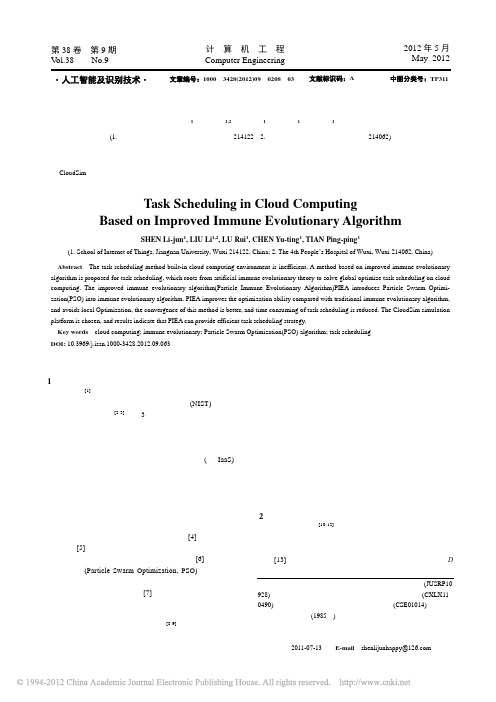
Task Scheduling in Cloud Computing Based on Improved Immune Evolutionary Algorithm
SHEN Li-jun1, LIU Li1,2, LU Rui1, CHEN Yu-ting1, TIAN Ping-ping1
(1. School of Internet of Things, Jiangnan University, Wuxi 214122, China; 2. The 4th People’s Hospital of Wuxi, Wuxi 214062, China) 【Abstract】The task scheduling method built-in cloud computing environment is inefficient. A method based on improved immune evolutionary algorithm is proposed for task scheduling, which roots from artificial immune evolutionary theory to solve global optimize task scheduling on cloud computing. The improved immune evolutionary algorithm(Particle Immune Evolutionary Algorithm)PIEA introduces Particle Swarm Optimization(PSO) into immune evolutionary algorithm. PIEA improves the optimization ability compared with traditional immune evolutionary algorithm, and avoids local Optimization, the convergence of this method is better, and time consuming of task scheduling is reduced. The CloudSim simulation platform is chosen, and results indicate that PIEA can provide efficient task scheduling strategy. 【Key words】cloud computing; immune evolutionary; Particle Swarm Optimization(PSO) algorithm; task scheduling DOI: 10.3969/j.issn.1000-3428.2012.09.063
《基于蜂群与遗传混合算法的多目标云工作流任务调度机制研究》范文
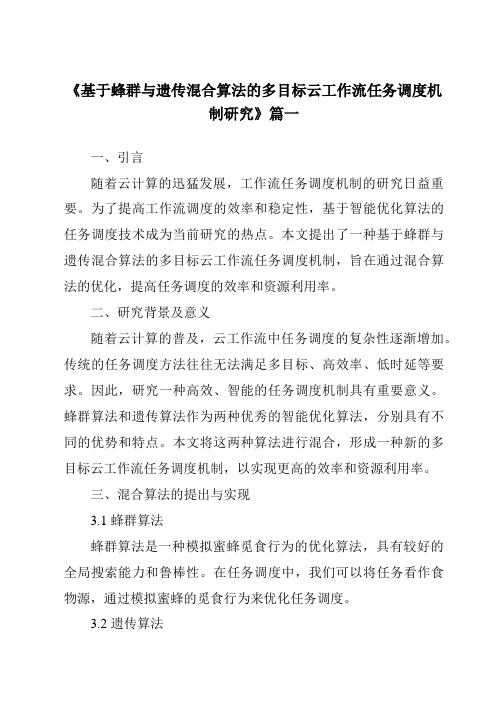
《基于蜂群与遗传混合算法的多目标云工作流任务调度机制研究》篇一一、引言随着云计算的迅猛发展,工作流任务调度机制的研究日益重要。
为了提高工作流调度的效率和稳定性,基于智能优化算法的任务调度技术成为当前研究的热点。
本文提出了一种基于蜂群与遗传混合算法的多目标云工作流任务调度机制,旨在通过混合算法的优化,提高任务调度的效率和资源利用率。
二、研究背景及意义随着云计算的普及,云工作流中任务调度的复杂性逐渐增加。
传统的任务调度方法往往无法满足多目标、高效率、低时延等要求。
因此,研究一种高效、智能的任务调度机制具有重要意义。
蜂群算法和遗传算法作为两种优秀的智能优化算法,分别具有不同的优势和特点。
本文将这两种算法进行混合,形成一种新的多目标云工作流任务调度机制,以实现更高的效率和资源利用率。
三、混合算法的提出与实现3.1 蜂群算法蜂群算法是一种模拟蜜蜂觅食行为的优化算法,具有较好的全局搜索能力和鲁棒性。
在任务调度中,我们可以将任务看作食物源,通过模拟蜜蜂的觅食行为来优化任务调度。
3.2 遗传算法遗传算法是一种模拟生物进化过程的优化算法,具有强大的全局寻优能力和较好的局部搜索能力。
在任务调度中,我们可以将任务和资源看作染色体,通过遗传操作来优化任务调度。
3.3 混合算法的实现本文将蜂群算法和遗传算法进行混合,形成一种新的多目标云工作流任务调度机制。
具体实现过程包括:首先,利用蜂群算法的全局搜索能力,对任务进行初步的分配和调度;然后,利用遗传算法的局部搜索能力,对调度结果进行优化;最后,通过多次迭代,得到最优的任务调度方案。
四、实验与分析4.1 实验环境与数据集本实验采用云工作流模拟器进行实验,并使用真实的工作流数据集进行验证。
实验环境包括多台虚拟机,模拟不同的云资源环境。
4.2 实验结果与分析通过实验,我们发现基于蜂群与遗传混合算法的任务调度机制在多目标优化、高效率和低时延等方面均表现出较好的性能。
与传统的任务调度方法相比,该机制能够更好地平衡任务负载、提高资源利用率、降低任务执行时延。
基于云计算的多目标优化算法研究
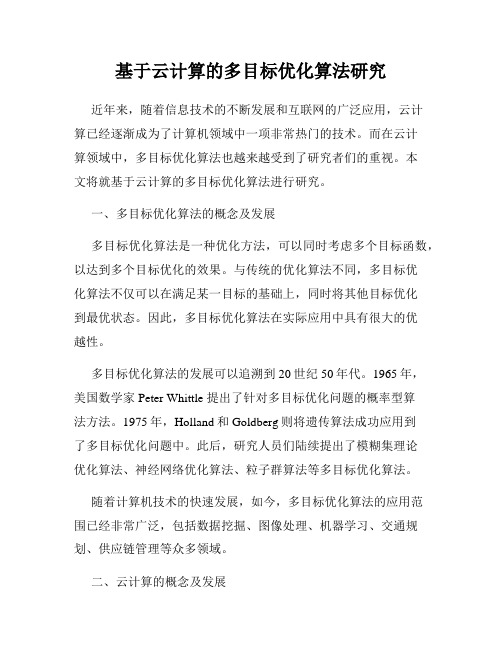
基于云计算的多目标优化算法研究近年来,随着信息技术的不断发展和互联网的广泛应用,云计算已经逐渐成为了计算机领域中一项非常热门的技术。
而在云计算领域中,多目标优化算法也越来越受到了研究者们的重视。
本文将就基于云计算的多目标优化算法进行研究。
一、多目标优化算法的概念及发展多目标优化算法是一种优化方法,可以同时考虑多个目标函数,以达到多个目标优化的效果。
与传统的优化算法不同,多目标优化算法不仅可以在满足某一目标的基础上,同时将其他目标优化到最优状态。
因此,多目标优化算法在实际应用中具有很大的优越性。
多目标优化算法的发展可以追溯到20世纪50年代。
1965年,美国数学家Peter Whittle 提出了针对多目标优化问题的概率型算法方法。
1975年,Holland和Goldberg则将遗传算法成功应用到了多目标优化问题中。
此后,研究人员们陆续提出了模糊集理论优化算法、神经网络优化算法、粒子群算法等多目标优化算法。
随着计算机技术的快速发展,如今,多目标优化算法的应用范围已经非常广泛,包括数据挖掘、图像处理、机器学习、交通规划、供应链管理等众多领域。
二、云计算的概念及发展云计算是一种利用网络来实现各方资源共享的计算模式。
它利用网络将计算资源、存储资源、通信资源整合起来,形成一个统一的资源池,供应用程序使用。
云计算技术的原理是将软件和数据存储在远端的服务器上,通过网络连接实现远程访问,使得用户可以通过互联网随时随地获取、共享、传输和存储信息。
这一技术可以为用户提供更好的服务质量和更为灵活的服务。
云计算的发展经历了三个阶段,即“基础架构即服务”(IaaS),“平台即服务”(PaaS)和“软件即服务”(SaaS)。
目前,云计算已经在多个领域中得到了广泛的应用,如教育、医疗、金融、零售、政府等领域。
三、基于云计算的多目标优化算法研究目前云计算已经成为IT领域的一个主要方向,对多目标优化算法的研究提出了更高的要求。
如何将多目标优化算法和云计算技术相结合,将是未来的一个重要方向。
基于粒子群的多目标多执行模式项目调度
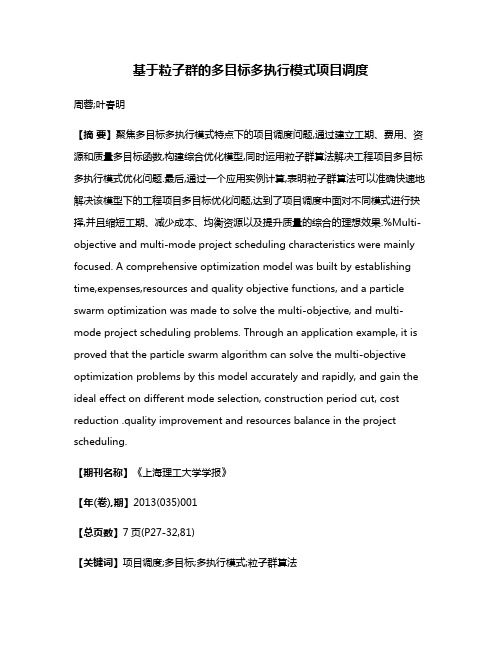
基于粒子群的多目标多执行模式项目调度周蓉;叶春明【摘要】聚焦多目标多执行模式特点下的项目调度问题,通过建立工期、费用、资源和质量多目标函数,构建综合优化模型,同时运用粒子群算法解决工程项目多目标多执行模式优化问题.最后,通过一个应用实例计算,表明粒子群算法可以准确快速地解决该模型下的工程项目多目标优化问题,达到了项目调度中面对不同模式进行抉择,并且缩短工期、减少成本、均衡资源以及提升质量的综合的理想效果.%Multi-objective and multi-mode project scheduling characteristics were mainly focused. A comprehensive optimization model was built by establishing time,expenses,resources and quality objective functions, and a particle swarm optimization was made to solve the multi-objective, and multi-mode project scheduling problems. Through an application example, it is proved that the particle swarm algorithm can solve the multi-objective optimization problems by this model accurately and rapidly, and gain the ideal effect on different mode selection, construction period cut, cost reduction .quality improvement and resources balance in the project scheduling.【期刊名称】《上海理工大学学报》【年(卷),期】2013(035)001【总页数】7页(P27-32,81)【关键词】项目调度;多目标;多执行模式;粒子群算法【作者】周蓉;叶春明【作者单位】上海理工大学管理学院,上海200093【正文语种】中文【中图分类】TP18;N94在工程项目调度中保持工期、成本、质量以及资源的均衡控制是构成项目建设总目标的关键因素,关系到整个工程的成败.为了实现工程项目的总效益,需要对工程项目所要求的质量、所规定的工期、所批准的费用等各个目标进行全方位的协调,因此建立一套科学有用的多目标多模式项目调度综合优化模型十分有必要.目前,解决工程项目优化问题的基本方法主要是网络计划技术,其在解决工程费用、工期、资源等单目标优化方面带来了极大方便.然而,现代的工程项目仅仅考虑单目标的优化是远远不行的.因此,许多专家希望引入最优化技术来研究工程项目多目标优化问题.如王首续[1]、骆刚等[2]将遗传算法引入工程项目优化问题,通过选择、变异、杂交等操作,实现工程项目多目标优化.刘永淞[3]则采用动态规划法(DP)研究工程项目优化问题.杨湘等[4]则应用模糊数学和遗传算法来解决工程项目资源均衡优化问题.粒子群算法(particle swarm optimization,PSO)是一种智能演化计算技术[5],系统初始化为一组随机解,通过迭代搜索最优值.与其它算法比较,PSO的优势在于算法简单和容易实现,同时又有深刻的智能背景,既适合科学研究,又特别适合工程应用.因此,PSO一经提出,立刻引起演化计算领域学者们的广泛关注,并在短短的几年时间里出现大量的研究成果,形成了一个研究热点[6].因此,本文主要以工程项目多目标多执行模式优化模型为研究对象,对项目调度所涉及的重要目标建立综合优化模型,并将粒子群算法引入工程项目优化领域,最终实现工程项目的工期、成本、质量以及资源的均衡性达到合理的配置.1 项目优化模型建立1.1 模型假设根据实际情况,对工程项目中工期、成本、质量以及资源等给予如下假设[7]:a.合理工期是工程项目在正常的条件情况下,使项目的投资方和各参建单位均获得满意的经济效益的工期.b.工程总成本是工程的直接成本与间接成本之和.c.工程总质量由各个单项任务的质量加权平均得到.d.本文的工期指工程项目的合理工期.e.本文直接成本主要指各类资源使用成本;间接成本主要指运输成本.f.工程质量与具体活动的施工组织方式有关,施工组织方式不同,单项工程的质量不同.本文问题具体可描述如下:一个工程中包含J项任务,规定任务j在其全部紧前任务i(i∈Pj,Pj为任务j的紧前任务集)完成之前不能开始.任务1是唯一最早开始的任务,任务J是唯一最晚完成的任务,均为虚拟任务,即不消耗资源且执行时间为0,表示整个工程的开始和结束.又规定任务j(j=1,2,…,J)必须选择Mj种执行模式之一执行,且在执行过程中不能中断或改变执行模式.在第m(1≤m≤Mj)种模式下任务j执行时间为djm.根据各任务在各执行模式下的最短执行时间,并利用传统的时间参数计算方法,可计算出各任务的最早、最晚完成时间窗口[EFj,LFj].同时,引进如下决策变量:1.2 项目工期模型工程项目的工期优化模型为为项目工期时间目标函数,式(1)表示确定最后一项任务结束的最小时间,即代表项目工期最短,tf表示项目执行时间;式(2)表示一项任务j只能在其执行模式mj中选择一种模式去完成;式(3)是紧前关系约束,其中i是j的紧前任务,djm表示任务j所需要的时间;式(4)表示每一阶段可更新资源k的消耗量不能超过其可用总量,其中rjmk指任务j在m模式下对可更新资源k的需求量,q为工序开始时间最大值,Rk为规定的资源消耗总量;式(5)确保了整个项目不可更新资源n的消耗量不能大于其总量Rn;式(6)则规定了变量的取值范围. 1.3 项目成本模型工程项目的成本优化模型为为项目成本目标函数,式(7)代表整个项目的资源消耗成本最小.其中,K为可更新资源总数;Ck表示第k种可更新资源的单位成本;C′k表示第k种可更新资源的每吨运输单位长度的成本(单位:元/(m·t)).同理,定义第n种不可更新资源的相关成本变量分别为Cn,C′n.式(8)指最后一项任务的开始时间STJ小于项目规定的工期结点D,即代表项目工期的约束.指整个工期内可更新资源k的最大消耗水平;为整个项目不可更新资源n的消耗量;定义为整个工期内可更新资源k的最大路径运输量,即任务j在m模式下的路径长度ljm与资源需求量rjmk的乘积;同理定义为整个项目不可更新资源n的最大路径运输量.1.4 项目资源均衡模型资源均衡优化就是在工程项目执行过程中,使资源计划使用量在整个工期内趋于均衡[8].在编制工程网络计划时,要对工作的实际时间进行适当地调整,减少资源使用量的高峰与低谷的差值,即达到资源方差值最小.目标函数如下s.t. 式(2)~(6)为资源均衡目标函数,即各时段资源消耗量与整个工期的平均消耗量的偏差的平方和,从而达到资源消耗的波动水平最小.其中,wk为可更新资源k的权重;wn为不可更新资源n的权重;指项目的完成时间;为项目中在时段t可更新资源k的消耗总量;表示可更新资源k在整个项目工期内的平均资源消耗水平;为项目中在时段t不可更新资源n的消耗总量;则表示不可更新资源n在整个项目工期内的平均资源消耗水平.1.5 项目质量模型考虑到工程质量的特殊性,这里对工程质量进行重新定义和假设.参照文献[9-12],本文在基本模型建立的基础上,采用专家估测法对工程质量进行评分,并确定单个活动在工程中所占的权重.具体目标函数如下FQ=为项目质量目标函数,式(10)表示质量最优.式中,wj指任务j的权重;qjm指任务j在m模式下的质量得分.1.6 多目标优化模型建立为了能够对工程项目进行综合优化,这里将前面的工期、成本、资源和质量各优化目标函数加权求和,建立多目标优化函数式中,WT、WC、WR、WQ 分别为各个目标函数的权重;由于各个模型的目标函数值具有不同的单位和量纲,在进行多目标决策之前先将这些目标无量纲化,即仅用数值的大小来反映各目标属性值的优劣,式中的则是将各目标函数通过无量纲化所得到的,具体为其中工期、成本、资源及质量各目标函数分别得到的最大、最小值为FTmax,FTmin,FCmax,FCmin,FRmax,FRmin和FQmax,FQmin.2 粒子群优化算法2.1 算法思想粒子群优化算法是由Eberhart博士与Kennedy博士发明的一种新的全局优化进化算法.该算法源于对鸟类捕食行为的模拟[6].粒子群优化算法首先初始化一群随机粒子,然后通过迭代找到最优解.在每一次迭代中,粒子通过跟踪两个“极值”来更新自己.一个是粒子本身所找到的最优解,即个体极值pbest.另一个是整个种群目前找到的最优解,称之为全局极值gbest.粒子在找到上述两个极值后,就根据下面两个公式来更新自己的速度与位置[6]:式中,V是粒子的速度;present是粒子的当前位置;rand()*是(0,1)之间的随机数;c1 和c2 被称作学习因子.通常,c1=c2=2,w 是加权系数,取值在0.1~0.9之间.根据上述公式,粒子最终飞至解空间中最优解所在的位置,搜索过程结束.最后输出的gbest就是全局最优解.在更新过程中,粒子每一维的最大速率被限制为Vmax,粒子每一维的坐标也被限制在允许范围之内.2.2 算法流程与步骤粒子群算法步骤如下[13]:步骤1 初始化群体规模为M的粒子群(在控制范围内随机设定位置和速度);步骤2 计算每个粒子的适应值f(p),p为粒子所处的位置;步骤3 将每个粒子适应值与其经历过的最好位置pbest作比较,如果f(pi)<f (pbesti),则f(pbesti)=f(pi);步骤4 将每个粒子适应值与全局极值gbest作比较,如果f(pi)<f(gbest),则f(gbest)=f(pi);步骤5 根据粒子群算法的进化方程,更新速度和位置;步骤6 若到达最大迭代次数G,输出结果;否则,返回步骤2.标准PSO算法流程如图1所示[14].图1 PSO算法流程图Fig.1 PSO procedure2.3 粒子群算法编码2.3.1 粒子编码与初始化在多执行模式的项目调度过程中,需要选择一个可行的执行模式和调度顺序.因此,本文算法中有两种类型的粒子:模式粒子和优先级粒子.其中,模式粒子用以选择执行模式,优先级粒子用以选择各个任务的调度顺序.这两种粒子数量相同,组合形成了一个调度方案.粒子群的搜索空间维度表示项目中的任务数,总数为J,模式粒子xim每个维度的值ximj都是随机值,大小不超过其对应的任务的可选模式总数,这个值表示任务j 所选择的模式.优先级粒子yim每个维度的值yimj都是[0,1]的随机实数,这个值的大小表示选择m模式的任务j调度的优先顺序,值越大越优先调度.为方便理解和计算,取虚拟开始任务的优先值为1,虚拟结束任务的优先值为0,其余任务都在(0,1)中取随机实数.经过简单的降序排序后就得到一个调度顺序,但是这个调度顺序可能不符合逻辑关系约束,即紧后任务的优先值可能大于其紧前任务的值,所以在生成一个调度顺序后,需要加入一个逻辑关系判断程序,以剔掉不符合要求的粒子.2.3.2 调度生成方式基于优先规则的调度生成方式可分为两种:串行调度方案(serial scheduling scheme,SSS)和并行调度方案(parallel scheduling scheme,PSS)[15],本文采用的是串行调度方案.串行调度方案的主要思路是:根据已经确定的调度顺序,按顺序加工,某个任务j的实际开始时间在其最早开始时间EFj与最晚开始时间LFj之间,在程序设计时,只需要判断在EFj和LFj之间,哪个时刻首先满足该任务的资源消耗量小于或等于该时刻的资源剩余总量,这个时刻便是该任务的实际开始时间Tf.依此类推,最后得到该调度顺序各个任务的实际开始时间、工期和成本等一系列目标值,然后通过适应度函数计算最优适应值.2.3.3 粒子更新方式粒子采用式(17)和式(18)对粒子速度和位置进行更新.更新后,如果模式粒子ximj<1,则ximj=1;如果ximj>M,则ximj=M.如果优先级粒子yimj≥1或者yimj≤0,yimj=rand.如果Vimj>1,则Vimj=1;如果Vimj<-1,则Vimj=-1.3 应用实例以国际标准问题库中的J1015-5.SM为测试问题,同时以实际项目经验所提供的基本数据为基础,应用基本粒子群算法求解上述模型下的多目标项目调度问题.作业及资源等信息如表1、表2(见下页)所示.表1 作业信息表Tab.1 Operation information资源405336499881043974487750同时,规定每单位数量资源运输单位长度所需成本为50;四大目标函数权重分别为WT=0.4,WC=0.25,WR=0.15,WQ=0.2.根据表1给出的逻辑关系,绘制出本项目的单代号网络图,如图2(见下页)所示.这里采用Matlab 7.0对以上算法编程,算法参数设置:学习因子c1=c2=2,由于该问题只有12个任务,属于比较简单的调度问题,所以种群规模和进化次数不用设置的太大,本文中设定种群规模M=20,进化次数Gmax=500;粒子群算法迭代运行次数为G=500;w取惯性权重,取值w=wmax-(wmax-wmin)/Dmax,wmax,wmin分别取0.9和0.4.通过500次迭代运算得到了如表3所示的结果.表2 资源信息表Tab.2 Resourcesinformation信息类别资源1资源2资源3资源4633500.30图2 项目网络图Fig.2 Project network diagram表3 单目标与多目标运行结果比较Tab.3 Comparison between single-target & multi-target running results成本185225193 730同时,可以得到该多目标模型下最优方案的具体模式选择情况以及任务对应的调度顺序,如表4所示.表4 最优方案任务执行信息表Tab.4 Details of the optimaldecision任务序号模式序号开始时间0000113795913通过500次进化运算,基本达到收敛性效果,计算平均运行时间为10min,达到平均最优值的比例为98.9%.同时,得到图3的多目标优化函数在此算例下的平均最优适应值曲线,即收敛图.由此可以看出,粒子群算法在求解该项目调度问题时方差较小,结果比较稳定.图3 算例收敛图Fig.3 Convergence of the case4 结束语本文提出在进行项目优化问题求解时,将控制目标有效地结合统一,形成一个综合、科学、有效的数学模型,这种思想是解决实际问题的根本和最优化设计成败的关键. 本文建立了工期—成本—资源均衡—质量的优化模型,并将各目标函数加权求和,采用单目标优化技术求解多目标优化问题,并采用粒子群优化算法求解工程项目多目标问题,能较好地平衡全局与局部搜索能力,保持种群的多样性,避免早熟.项目实例验证结果表明,该综合优化模型具有较好的适用性,粒子群优化算法在求解该多目标项目优化模型问题时具备可行性,并且基本达到了预期理想的结果.【相关文献】[1]王首续,周学林.遗传算法优化施工网络计划的多种资源均衡[J].重庆交通学院学报,2001,20(2):39-45.[2]骆刚,刘尔烈,王健.遗传算法在网络计划资源优化中的应用[J].天津大学学报,2004,37(2):179-183.[3]刘永淞.DP法工期优化[J].湘潭大学学报,2002,24(1):106-108.[4]杨湘,张连营.工程项目工期——成本综合模糊优化[J].土木工程学报,2003,36(3):46-50.[5]刘寅,马良,黄珏.基于模糊粒子群算法的非线性函数优化[J].上海理工大学学报,2012,34(4):314-322.[6]Kennedy J,Eberhart R C.Particle swarm optimization[C]∥IEEE InternationalConference on Neural Networks,Perth,1995.[7]与科学王维博,冯全源.基于改进粒子群算法的工程项目综合优化[J].西南交通大学学报,2011,46(1):76-83.[8]齐东海,宋向群.工程项目进度管理[M].大连:大连理工大学出版社,2001.[9]王健,刘尔烈,骆刚.工程项目管理中工期成本质量综合均衡优化[J].系统工程学报,2004,19(2):148-153.[10]杨耀红,汪应洛,王能民.工程项目工期成本质量模糊均衡优化研究[J].系统工程理论与实践,2006,26(7):114-117.[11]Kaheled E, Amr K. Time-cost-quality-trade-off analysis for highway construction[J].Journal of Construction Engineering and Management,2005,131(4):477-485.[12]Afshar A,Kaveh A,Shoghli O R.Multi-objective optimization of time-cost-quality using multicolonyant algorithm [J].Asian Journal of Civil Engineering(Building and Housing),2007,8(2):113-124.[13]陈志勇,杜志达,周华.基于微粒群算法的工程项目资源均衡优化[J].土木工程学报,2007,40(2):93-96.[14]杨维,李歧强.粒子群算法综述[J].中国工程科学,2004,6(5):87-95.[15]Kolisch R.Serial and parallel resource-constrained project scheduling methods revisited:theory and computation[J].European Journal of Operational Research,1996,90(2):320-333.。
多目标猫群优化算法支持下的云计算任务调度
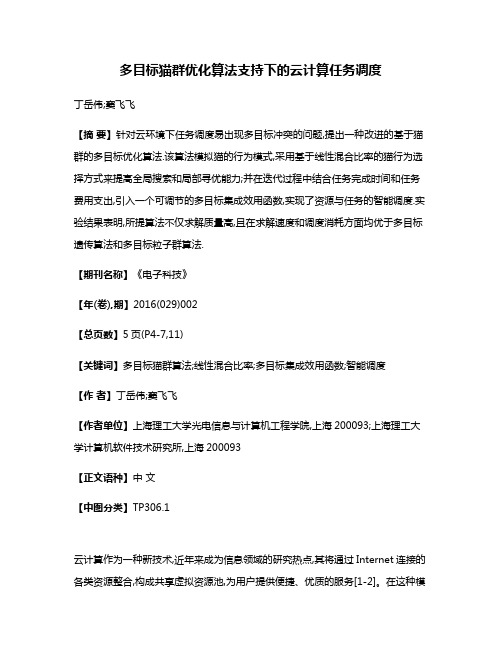
多目标猫群优化算法支持下的云计算任务调度丁岳伟;窦飞飞【摘要】针对云环境下任务调度易出现多目标冲突的问题,提出一种改进的基于猫群的多目标优化算法.该算法模拟猫的行为模式,采用基于线性混合比率的猫行为选择方式来提高全局搜索和局部寻优能力;并在迭代过程中结合任务完成时间和任务费用支出,引入一个可调节的多目标集成效用函数,实现了资源与任务的智能调度.实验结果表明,所提算法不仅求解质量高,且在求解速度和调度消耗方面均优于多目标遗传算法和多目标粒子群算法.【期刊名称】《电子科技》【年(卷),期】2016(029)002【总页数】5页(P4-7,11)【关键词】多目标猫群算法;线性混合比率;多目标集成效用函数;智能调度【作者】丁岳伟;窦飞飞【作者单位】上海理工大学光电信息与计算机工程学院,上海200093;上海理工大学计算机软件技术研究所,上海200093【正文语种】中文【中图分类】TP306.1云计算作为一种新技术,近年来成为信息领域的研究热点,其将通过Internet连接的各类资源整合,构成共享虚拟资源池,为用户提供便捷、优质的服务[1-2]。
在这种模式下,如何快速实现资源与用户需求的智能匹配和多目标优化调度尤为重要[3]。
目前,云计算调度中多目标优化问题通常采用启发式算法,其中较典型的有多目标遗传算法、多目标粒子群法等。
但多目标遗传算法具有参数复杂、局部搜索能力不足、搜索速度慢等缺点[4];多目标粒子群收敛速度快,但由于自身机制更新的限制,求解离散问题时易陷入局部最优[5]。
猫群算法(Cat Swarm Optimization,CSO)是由Shu-Chuan Chu等人在2006年提出的一种基于猫的群体智能算法[6]。
在猫群算法应用方面,Santosa[7]提出利用猫群算法来解决聚类问题;刘琼等人[8]提出利用多目标猫群算法来求解混流装配线排序问题。
虽然猫群算法在众多问题上取得了较好的应用,但在云计算任务调度方面的研究并不多,其具有较强的研究意义。
- 1、下载文档前请自行甄别文档内容的完整性,平台不提供额外的编辑、内容补充、找答案等附加服务。
- 2、"仅部分预览"的文档,不可在线预览部分如存在完整性等问题,可反馈申请退款(可完整预览的文档不适用该条件!)。
- 3、如文档侵犯您的权益,请联系客服反馈,我们会尽快为您处理(人工客服工作时间:9:00-18:30)。
I.J. Information Technology and Computer Science, 2015, 05, 61-66Published Online April 2015 in MECS (/)DOI: 10.5815/ijitcs.2015.05.09Multi-Objective Task Scheduling in the Cloud Computing based on the Patrice SwarmOptimizationFarnaz Sharifi MilaniDepartment of Computer, East Azarbaijan Science and Research Branch, Islamic Azad University, Tabriz, IranEmail: f.sharifi@iauasrb.ac.irAhmad Habibizad Navin*Department of Computer, East Azarbaijan Science and Research Branch, Islamic Azad University, Tabriz, IranEmail: habibizad@iauasrb.ac.irAbstract—Cloud computing is the latest emerging trend in distributed computing, where shared resources are provided to end-users in an on demand fashion that brings many advantages, including data ubiquity, flexibility of access, high availability of resources, and flexibility. In this type of systems many challenges are existed that the task scheduling problem is one of them. The task scheduling problem in Cloud computing is an NP-hard problem. Therefore, many heuristics have been proposed, from low level execution of tasks in multiple processors to high level execution of tasks. In this paper, we propose a new algorithm based on PSO to schedule the tasks in the Cloud. The results demonstrated that the proposed algorithm has a better operation in terms of task execution time, waiting time and missed tasks in comparison of First Come First Served (FCFS), Shortest Process Next (SPN) and Highest Response Ratio Next (HRRN).Index Terms—Cloud Computing, Scheduling, PSO, NetworkI.I NTRODUCTIONThe ―Cloud‖the metaphor is a reference to the ubiquitous availability and accessibility of computing resources via Internet technologies [1]. Cloud computing as a novel and entirely internet-based approach is an important concept in today’s distributed systems [2]. It is used chiefly for business applications in which computers cooperate to perform a specific service [3]. It evolved through the recent advancements in hardware, virtualization technology, distributed computing, and service delivery over the Internet. While Cloud computing may not involve a lot of new technologies, it certainly represents a new way of managing IT. In many cases, this will not only change the workflow within the IT organization, it will often result in a complete reorganization of the IT department. Cost savings and scalability can be highly achieved from cloud computing [4]. Cloud computing, which is aimed at providing infrastructures, platforms and software as services has been introduced and implemented in the last few years. It is widely recognized as the next generation of computing architecture [5]. Generally, Cloud computing services can be categorized into three main types of services: Infrastructure as a Service, Platform as a Service and Software as a Service. These services can then be accessed through a cloud client which could be a web browser, mobile app, and so on [6]. Cloud computing provides implementation agility, lower capital expend-iture, location independence, resource pooling, broad network access, reliability, scalability, elasticity, and ease of maintenance [7, 8]. Also it offers numerous advantages for data and software sharing and thus making the management of complex IT systems much simpler [9, 10]. Job scheduler is a vital part of any distributed system like Grid [11-13], Cloud [14-17] and P2P networks [18-20] which assigns jobs to suitable resources for execution. The scheduling of a task workflow in a distributed computing platform is a well-known NP-hard problem [21]. The problem is even more complex and challenging when the virtualized clusters are used to execute a large number of tasks in a Cloud computing platform [21, 22]. For this reason, many heuristics have been proposed, from low level execution of tasks in multiple processors to high level execution of tasks in Grid and Cloud environments [23]. Recently many papers are published which used evolutionary algorithms like genetic, ant colony, bee colony and PSO (Particle Swarm Optimization) for optimization problems[21]. Because of the success of the PSO algorithms, in this paper we propose a new method based on the PSO algorithm for task scheduling in Cloud computing. The proposed method use a multi-objective function for increasing the effectiveness of algorithm.The rest of this paper is organized as follow. In section 2, the related works are briefly reviewed. Section 3 describes the proposed method. In section 4 the obtained results are presented. Finally, last section concludes the paper and suggests some suggestions for future researches.II.R ELATED W ORKSIn this section, the state of the art mechanisms and approaches of task scheduling in the Cloud systems are briefly reviewed and analyzed based on published years.62Multi-Objective Task Scheduling in the Cloud Computing based on the Patrice Swarm Optimization∙2011Garg, Yeo [24] have proposed the near-optimal scheduling policies to exploit heterogeneity across multiple data centers for a Cloud provider. The method is considered a number of energy efficiency factors (such as energy cost, carbon emission rate, workload, and CPU power efficiency) which change across different data centers depending on their location, architectural design, and management system. The have demonstrated that the proposed method can able to achieve on average up to 25% of energy savings in comparison to profit based scheduling policies. Mezmaz, Melab [25] have investigated the problem of scheduling precedence-constrained parallel applications on heterogeneous computing systems like cloud computing infrastructures. They have proposed a new parallel bi-objective hybrid genetic algorithm based on dynamic voltage scaling (DVS) that takes into account, not only makespan, but also energy consumption.∙2012Li, Qiu [26] have proposed two online dynamic resource allocation algorithms for the IaaS Cloud system with preemptable tasks. They algorithms adjusted the resource allocation dynamically based on the updated information of the actual task executions and the experimental results demonstrated that the proposed algorithms can significantly improve the performance in the situation where resource contention is fierce. Also Abrishami and Naghibzadeh [27] have proposed a new QoS-based workflow scheduling algorithm based on a novel concept called Partial Critical Paths (PCP), which tries to minimize the cost of workflow execution while meeting a user-defined deadline. Lu, Jiang [28] have proposed a resources collaboration scheduling model to improve the efficiency of the virtual resources collaboration scheduling. The proposed model is based on virtual organization and makes use of the trust mechanism to estimate the credibility of the virtual organization. Finally, Wang, Zeng [29] have presented a Bayesian method based cognitive trust model, and a trust dynamic level scheduling algorithm named Cloud-DLS (Dynamic Level Scheduling) by integrating the existing DLS algorithm [30].∙2013Van den Bossche, Vanmechelen [31] have proposed a workload model which is considers non-preemptible and non-migratable workloads with a hard deadline that are characterized by CPU, memory and data transmission requirements. Also, Wang, Wang [32] have proposed a genetic algorithm for Cloud resource optimization scheduling model that promised the user needs while optimizing resource allocation. Laili, Tao [14] have combined the Service Composition Optimal Selection (SCOS) and Optimal Allocation of Computing Resources (OACR) into one-time decision in one console, named Dual Scheduling of Cloud Services and Computing Resources (DS-CSCR). Wu, Liu [16] have proposed a market-oriented hierarchical scheduling strategy in Cloud workflow systems.∙2014Frîncu [33] have presented a solution based on genetic algorithm to finding the optimal number of component types needed on nodes so that every type is present on every allocated node. The have tested the algorithm in terms of node load, closeness to the optimal solution and proved the algorithm’s efficiency. Tao, Feng [15] have proposed Case Library and Pareto Solution based hybrid Genetic Algorithm CLPS-GA for Optimal Scheduling of Computing Resources (OSCR). Liu, Qu [34] have proposed a fuzzy clustering method to effectively pre-process the Cloud resources. They have proposed a new directed acyclic graph based scheduling algorithm called earliest finish time duplication algorithm for heterogeneous Cloud systems by combining the list scheduling with the task duplication scheduling scheme. Finally, the experiment demonstrates that the proposed algorithm is effectual and well-organized. Finally, Jung, Lim [35] have presented the workflow scheduling scheme that reduces the task waiting time when an instance occurs the out-of-bid situation.III.P ROPOSED M ETHODIn this section we propose a new method based on PSO for task scheduling in Cloud computing. First, the problem statement is described.A.Problem StatementFor stating the problem we use a DAG (Directed Acyclic Graph) which is a directed graph with no directed cycles. It is formed by a collection of vertices and directed edges, each edge connecting one vertex to another, such that there is no way to start at some vertex v and follow a sequence of edges that eventually loops back to v again [36, 37].Fig. 1. An example of a DAG with 8 tasks and three resourcesIn a DAG vertices denote tasks and edges represent precedence constraints and/or data movements among tasks. Given a set of resources, a schedule for a DAG is an assignment which specifies the mapping of tasks and T0T1T3T4T5T6T7T2T0={8, 20, M}, T1={6, 12, L}T2={7, 15, H}, T3={6, 15, H}T4={8, 18, L}, T5={4, 14, H}T6={7, 20, M}, T7={6, 10, M}resources and the estimated start time of each task on the mapped resource. Here, the aims of DAG scheduling is to minimize the overall execution time, waiting time and the missed tasks. Fig. 1 represents an example of DAG. In this example, three resources and eight tasks are exist. Each task have three properties {ET1, deadline, priority}.B.Swarm IntelligenceSwarm intelligence refers to collective intelligence. Biologists and natural scientist have been studying the behavior of social insects due to their efficiency of solving complex problems such as finding the shortest path between their nest and food source or organizing their nests. In spite of the fact that these insects are unsophisticated individually, they make wonders as a swarm by interaction with each other and their environment. In last two decades, the behaviors of various swarms that are used in finding preys or mating are simulated into a numerical optimization technique. The collective intelligence emerges from a self-organization process of agents evolving autonomously according to a set of internal rules specifying its motion patterns and interaction with the environment and other agents, such that intelligent collective behavior arises from simple individual behaviors [38]. Some important swarm intelligence techniques are ant colony optimizer, particle swarm optimizer, artificial bee colony algorithm, glowworm algorithm, firefly algorithm, cuckoo search algorithm, bat algorithm, and hunting search algorithm [39]. Most of the swarm intelligence–based algorithms are simple and robust techniques that determine the optimum solution of optimization problems efficiently without requiring much of a mathematical struggling. PSO has attracted significant attention since its inception because of its simplicity and effectiveness in solving various optimization problems [40]. Therefore, we choose PSO for solving the stated problem.C.The proposed methodPSO is a metaheuristic algorithm which is developed by Kennedy and Eberhart [41] to find good solutions in optimization problems which takes its inspiration from the cooperation and communication of a swarm of birds. Inspired by social models and swarming theory, it consists of a swarm that collectively explore the solution search space of an optimization problem and stores the best solutions found. In PSO, each individual in the swarm, called a particle, behaves like an agent of a highly decentralized and intelligent environment. Each particle of the swarm contributes to the environment by following very simple rules, thus cooperating and communicating with other particles of the swarm [42]. Particles are attracted at each iteration to the best solutions found by themselves and to the best solutions found by their neighbors, thereby encouraging the exploration of nearby solutions to potentially find better ones [43]. Analogous to other evolutionary algorithms, such as GA and ACO, PSO is a population-based stochastic optimization 1 Execution Time algorithm. A swarm of particles attempts to search for superior solutions through learning, communication and interaction. The position of each particle refers to a solution. The state of particle i is described by its current position x i = [x i1, x i2, …x iD] and velocity v i = [v i1, v i 2, …v iD], where D is the number of variables encountered in the optimization problem. In the generic PSO with inertia weight [44], the position and velocity of particle i are updated during the evolutionary process [40]:=w× + c1 × × ( - )+ c2 × × (- ) (1)=+ (2) where is the d th variable of the position of particle i;is the d th variable of the velocity of particle i;is the d th variable of the personal historical best position found by particle i; is the d th variable of the global best position found by the whole swarm; c1 and c2are the acceleration parameters commonly set to 2.0;and are two random numbers drawn from a uniform distribution over [0, 1] and w is the inertia weight used to set up the balance between the abilities of global and local search features of PSO [40, 44].a. Solution RepresentationAs a first step in PSO, the candidate solutions must be encoded in a suitable form. Here, the solution is represented as a string of length n, where n is the number of the requested tasks. For example, fig. 2 represents a solution with 6 tasks and 4 servers. According to fig. 2, T1 is assigned to S1 (first server), T2 and T6 are assigned to S3 and so on.342431Fig. 2. An example of solution with 6 tasks and 4 serverb. Particle FitnessFitness or quality value shows how fit the solution is, i.e. how well it adapts to its environment. For a maximization problem, the fitness of a solution can be proportional to the value of the objective function [21]. We uses three terms including total execution time (Ttime), average of waiting time (Wtime) and numbers of missed tasks because of their deadline (Missed) for designing fitness function as follow:FF1= 1/Ttime, (3) FF2= 1/Wtime, (4) FF=, (5) Where the aim of PSO is to maximize the value of FF.c. Termination ConditionThe algorithm is ran until no improvement in the fitness of the gbest has been observed for 10 generations or maximum iterations is reached.d. Pseudo CodeIn this section the pseudo code of the proposed algorithm is described as follows:∙For each particle∙Initialize particle∙End For∙Do∙For each particle∙Calculate the fitness value of the particle fp∙/*updating particle’s best fitness value so far) */∙If fp is better than pbest∙Set current value as the new pbest∙End For∙/*updating population’s best fitness value so far)*/ ∙Set gbest to the best fitness value of all particles∙For each particle∙Calculate the particle velocity according to (1)∙Update particle position according to (2)∙End For∙End Do While maximum iterations OR no improvement in gbest in 10 interactions are reached.IV.S IMULATION R ESULTSIn this section, we present the results to evaluate the performance of the proposed method using Matlab. We suppose the number of resources in the Cloud is 8 and the number of tasks are 40 where their execution and creation time are listed in table 1.Table 1. Arrival time, service time, deadline and dependency of 40tasksTask # ArrivalTimeServiceTimeDeadline Dependency1 1448-----2 1524-----3 1951014 1481615 9918-----6 92427 61258 18816-----9 20361, 710 25102, 5, 711 71020612 186121013 20367, 1314 910208, 1015 159185, 316 99181017 3714-----18 4361119 55101620 74815, 221 83615, 1122 212-----23 137148, 9, 1324 5816525 78161, 1426 2036-----27 13247, 1128 0102022, 2629 17918830 1161221312061219, 2932661216, 19, 2733114816341071423359918173618481637412-----38134831391771412, 244011246, 37To study the effectiveness of the proposed method, we compare it with First Come First Served (FCFS), Shortest Process Next (SPN) and Highest Response Ratio Next (HRRN). Fig 3 illustrates the simulation result based on the overall execution time that the PSO has better performance.Fig 4 illustrates the simulation result based on the average service time + waiting time that the PSO has better performance.Fig 5 illustrates the simulation result based on the average of missed tasks that the SPN has better performance.Finally, Fig 6 illustrates the simulation result based on the resource utilization that the PSO has better performance.Fig. 3. The simulation result based on the overall execution time102030405060FCFS SPN HRRN PSOTimeMethodFig. 4. The simulation result based on the average service time +waiting timeFig. 5. The simulation result based on the average of missed tasksFig. 6. The simulation result based on the resource utilizationV. C ONCLUSION AND F UTURE W ORKSCloud computing as a novel and entirely internet-based approach is an important concept in distributed systems. In Cloud computing, shared resources are provided to end-users in an on demand fashion that brings many advantages, including data ubiquity, flexibility of access, high availability of resources, and flexibility. In this typeof systems many challenges are existed that the task scheduling problem is one of them. In this paper, a new algorithm based on PSO is proposed to schedule the tasks in the Cloud. The results demonstrated that the proposed algorithm has a better operation in terms of task execution time, waiting time and missed tasks in comparison of FCFS, SPN and HRRN. In the future, we plan to modify the proposed method to support the heterogeneous resources.R EFERENCES[1] Oliveira, T., M. Thomas, and M. Espadanal, Assessing thedeterminants of cloud computing adoption: An analysis of the manufacturing and services sectors. Information & Management, 2014. 51(5): p. 497-510.[2] Jafari Navimipour, N., et al., Expert Cloud: a Cloud-basedframework to share the knowledge and skills of human resources Computer in Human Behaviour, 2014.[3] Wang, S.-S. and S.-C. Wang, The consensus problem withdual failure nodes in a cloud computing environment. Information Sciences, 2014. 279(0): p. 213-228.[4] Manvi, S.S. and G. Krishna Shyam, Resource managementfor Infrastructure as a Service (IaaS) in cloud computing: A survey. Journal of Network and Computer Applications, 2014. 41(0): p. 424-440.[5] Liu, W., et al., Adaptive resource discovery in mobilecloud computing. Computer Communications, 2014. 50(0): p. 119-129.[6] Chong, H.-Y., J.S. Wong, and X. Wang, An explanatorycase study on cloud computing applications in the built environment. Automation in Construction, 2014. 44(0): p. 152-162.[7] Gurkok, C., Chapter 4 - Securing Cloud ComputingSystems , in Network and System Security (Second Edition), J.R. Vacca, Editor. 2014, Syngress: Boston. p. 83-126. [8] Nandhini, A. and B. Saravana Balaji, Energy-Efficient PSOand Latency Based Group Discovery Algorithm in Cloud Scheduling. International Journal of Information Technology and Computer Science, 2014 6(10).[9] Jou, M. and J. Wang, Observations of achievement andmotivation in using cloud computing driven CAD: Comparison of college students with high school and vocational high school backgrounds. Computers in Human Behavior, 2013. 29(2): p. 364-369.[10] Jafari Navimipour, N., et al., Behavioral modelling andautomated verification of a Cloud-based framework to share the knowledge and skills of human resources. Computer in Industry, 2014.[11] Jafari Navimipour, N. and L. Mohammad Khanli. The LGRmethod for task scheduling in computational grid . in Advanced Computer Theory and Engineering, 2008. ICACTE'08. International Conference on . 2008. IEEE. [12] Habibizad Navin, A., et al., Expert Grid: New Type of Gridto Manage the Human Resources and Study the Effectiveness of its Task Scheduler. Arabian Journal for Science and Engineering, 2014.[13] Jafari Navimipour, N., et al., Resource discoverymechanisms in grid systems: A survey. Journal of Network and Computer Applications, 2014. 41: p. 389-410.[14] Laili, Y., et al., A Ranking Chaos Algorithm for dualscheduling of cloud service and computing resource in private cloud. Computers in Industry, 2013. 64(4): p. 448-463.2468101214FCFSSPNHRRNPSOT i m e Method0%5%10%15%20%25%30%FCFSSPN HRRNPSOM i s s e d T a s k s Method 010203040506070809010012345678U t i l i z a t i o n R a t e (%)ResourcesFCFSSPN[15] Tao, F., et al., CLPS-GA: A case library and Paretosolution-based hybrid genetic algorithm for energy-aware cloud service scheduling.Applied Soft Computing, 2014.19(0): p. 264-279.[16] Wu, Z., et al., A market-oriented hierarchical schedulingstrategy in cloud workflow systems.The Journal of Supercomputing, 2013. 63(1): p. 256-293.[17] Navimipour, N.J., et al., Job scheduling in the ExpertCloud based on genetic algorithms.Kybernetes, 2014.43(8): p. 12-12.[18] Montazeri, A., B. Akbari, and M. Ghanbari, An incentivescheduling mechanism for peer-to-peer video streaming.Peer-to-Peer Networking and Applications, 2012. 5(3): p.257-278.[19] Rius, J., F. Cores, and F. Solsona, Cooperative schedulingmechanism for large-scale peer-to-peer computing systems.Journal of Network and Computer Applications, 2013.36(6): p. 1620-1631.[20] Jafari Navimipour, N. and F. Sharifi Milani, Acomprehensive study of the resource discovery techniques in Peer-to-Peer networks.Peer-to-Peer Networking and Applications, 2015: p. 1-19.[21] Jafari Navimipour, N. and F. Sharifi Milani, TaskScheduling in the Cloud Computing based on the Cuckoo Search Algorithm.International Journal of Modeling and Optimization, 2014.[22] Zhang, F., et al., Multi-objective scheduling of many tasksin cloud platforms. Future Generation Computer Systems,(0).[23] Gutierrez-Garcia, J.O. and K.M. Sim, A family ofheuristics for agent-based elastic Cloud bag-of-tasks concurrent scheduling.Future Generation Computer Systems, 2013. 29(7): p. 1682-1699.[24] Garg, S.K., et al., Environment-conscious scheduling ofHPC applications on distributed Cloud-oriented data centers.Journal of Parallel and Distributed Computing, 2011. 71(6): p. 732-749.[25] Mezmaz, M., et al., A parallel bi-objective hybridmetaheuristic for energy-aware scheduling for cloud computing systems.Journal of Parallel and Distributed Computing, 2011. 71(11): p. 1497-1508.[26] Li, J., et al., Online optimization for schedulingpreemptable tasks on IaaS cloud systems.Journal of Parallel and Distributed Computing, 2012. 72(5): p. 666-677.[27] Abrishami, S. and M. Naghibzadeh, Deadline-constrainedworkflow scheduling in software as a service Cloud.Scientia Iranica, 2012. 19(3): p. 680-689.[28] Lu, K., et al. Resources collaborative scheduling modelbased on trust mechanism in cloud. in Trust, Security and Privacy in Computing and Communications (TrustCom), 2012 IEEE 11th International Conference on. 2012. IEEE.[29] Wang, W., et al., Cloud-DLS: Dynamic trusted schedulingfor Cloud computing.Expert Systems with Applications, 2012. 39(3): p. 2321-2329.[30] Dogan, A. and F. Ozguner, Matching and schedulingalgorithms for minimizing execution time and failure probability of applications in heterogeneous computing.Parallel and Distributed Systems, IEEE Transactions on, 2002. 13(3): p. 308-323.[31] Van den Bossche, R., K. Vanmechelen, and J. Broeckhove,Online cost-efficient scheduling of deadline-constrained workloads on hybrid clouds. Future Generation Computer Systems, 2013. 29(4): p. 973-985.[32] Wang, Y., et al., Resource scheduling of cloud with QoSconstraints, in Advances in Neural Networks–ISNN 2013.2013, Springer. p. 351-358. [33] Frîncu, M.E., Scheduling highly available applications oncloud environments. Future Generation Computer Systems, 2014. 32: p. 138-153.[34] Liu, Z., et al., Resource preprocessing and optimal taskscheduling in cloud computing environments. Concurrency and Computation: Practice and Experience, 2014.[35] Jung, D., et al., A Workflow Scheduling Technique for TaskDistribution in Spot Instance-Based Cloud, in Ubiquitous Information Technologies and Applications, Y.-S. Jeong, et al., Editors. 2014, Springer Berlin Heidelberg. p. 409-416.[36] T hulasiraman, K. and M. Swamy, Acyclic Directed Graphs.Graphs: Theory and Algorithms, 1992.[37] Baioletti, M., G. Busanello, and B. Vantaggi, Acyclicdirected graphs representing independence models.International Journal of Approximate Reasoning, 2011.52(1): p. 2-18.[38] Rebollo-Ruiz, I. and M. Graña, An empirical evaluation ofGravitational Swarm Intelligence for graph coloring algorithm. Neurocomputing, 2014. 132(0): p. 79-84. [39] Saka, M.P., E. Doğan,and I. Aydogdu, 2 - Analysis ofSwarm Intelligence–Based Algorithms for Constrained Optimization, in Swarm Intelligence and Bio-Inspired Computation, X.-S. Yang, et al., Editors. 2013, Elsevier: Oxford. p. 25-48.[40] Wu, G., et al., Superior solution guided particle swarmoptimization combined with local search techniques.Expert Systems with Applications, 2014. 41(16): p. 7536-7548.[41] Kennedy, J. and R. Eberhart. Particle swarm optimization.in Proceedings of IEEE international conference on neural networks. 1995. Perth, Australia.[42] Alam, S., et al., Research on particle swarm optimizationbased clustering: A systematic review of literature and techniques.Swarm and Evolutionary Computation, 2014.17(0): p. 1-13.[43] Rada-Vilela, J., M. Johnston, and M. Zhang, Populationstatistics for particle swarm optimization: Resampling methods in noisy optimization problems.Swarm and Evolutionary Computation, 2014. 17(0): p. 37-59.[44] Shi, Y. and R. Eberhart. A modified particle swarmoptimizer. in Evolutionary Computation Proceedings, 1998.IEEE World Congress on Computational Intelligence., The 1998 IEEE International Conference on. 1998. IEEE. Authors’ ProfilesFarnaz Sharifi Milani is a M.Sc. student in Department of Computer Engineering, East Azarbaijan Science and Research Branch, Islamic Azad University, Tabriz, Iran since 2013. She received her B.S. degree in Information Technology Engineering from Tabriz Branch, Islamic Azad University, Tabriz, Iran in 2010. Her current research interests are focused on wireless sensor networks, Peer to Peer networks, Cloud computing and Network-on-Chip.Ahmad Habibizad Navin was born in 1971. He received his H.N.D in electronic in1997 and B.Sc. degree in applied mathematics from Tabriz University, Tabriz, Iran, in 1999. He received his M.Sc. degree in computer architecture from Science and Research Branch of Islamic Azad University, Tehran, Iran, in 2003 and his Ph.D. in computer hardware from Science and Research Branch, Islamic Azad University, Tehran, Iran, in 2007. His research interest includes computer architecture, data-oriented approach, robotic, soft computing and probability and statistic.。
